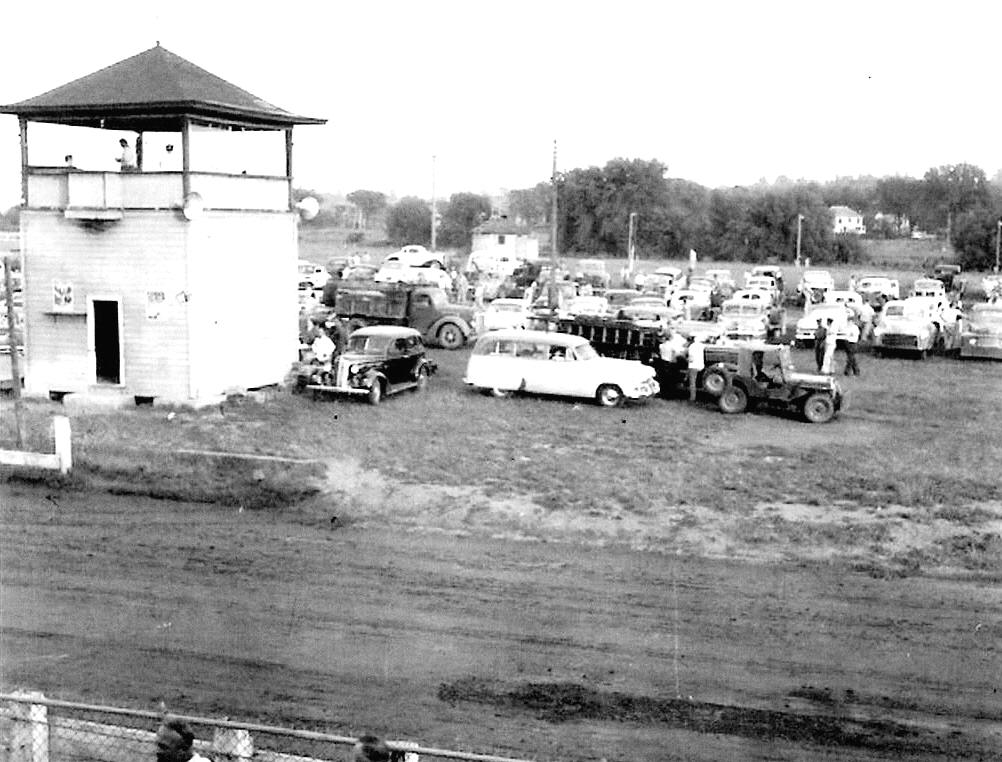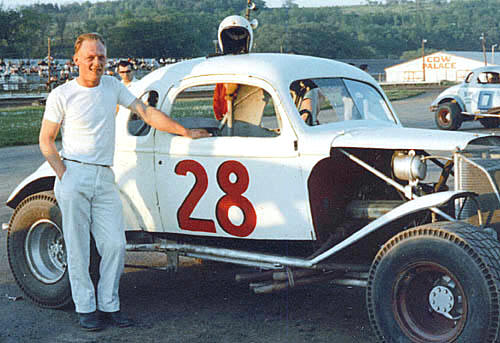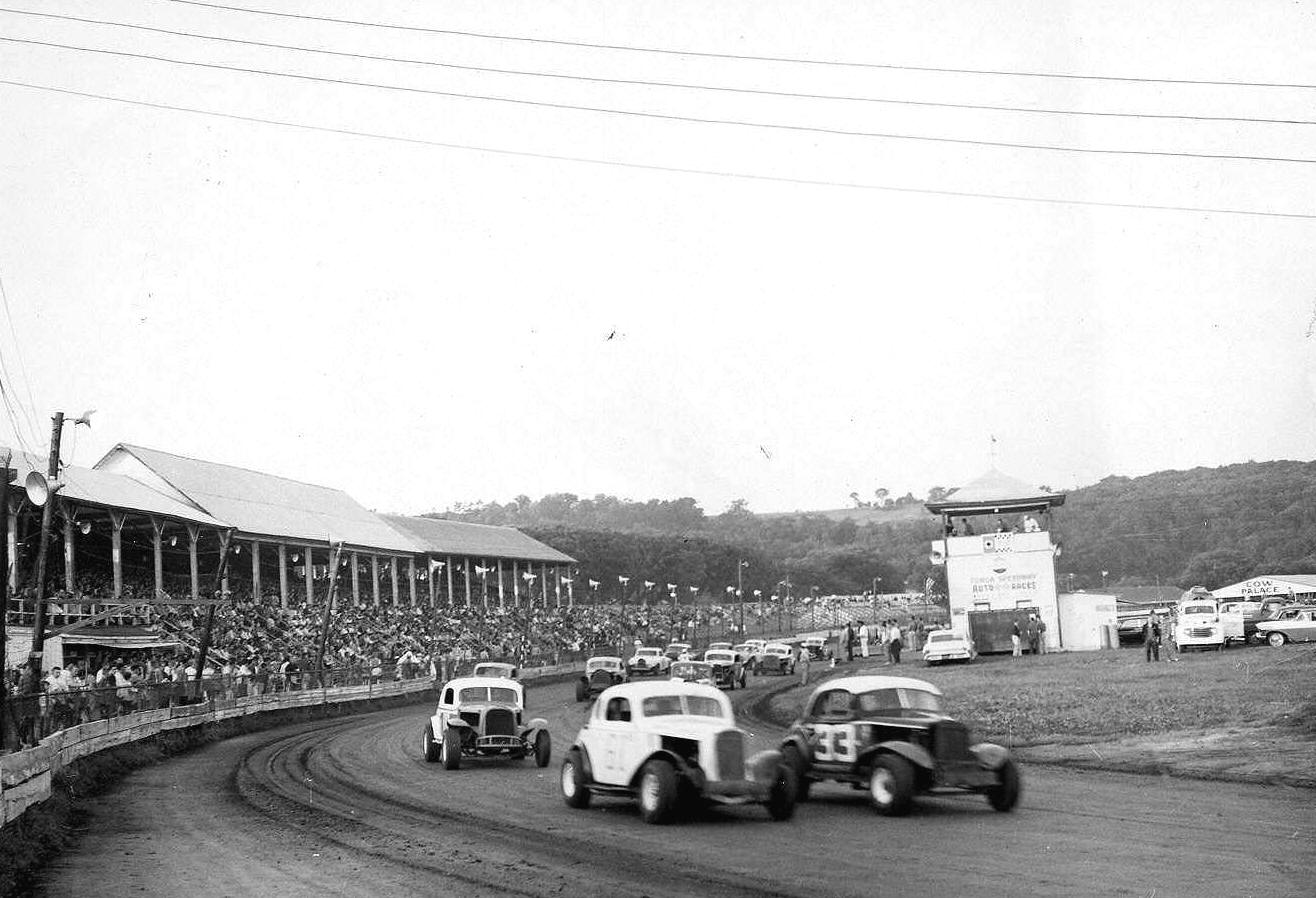
The photo shows a lot, all in one view. It is clearly Fonda, pre-1960’s. The 1952 Chevy station wagon is
very likely Steve Danish's. [Dan Ody Collection]
THE
BILL'S BACK IN TIME COLUMN PAGE
Copies of my column in Mark Thomas' "Racin'
Paper"
BILL’S BACK IN TIME
By Bill Ladabouche
Column 73 From Original Column 88
BILL’S BACK IN TIME
By Bill Ladabouche
ALL FROM ONE PHOTO
ALL FROM ONE PHOTO
I occasionally buy photos from the booth of Danny Ody, at the Camelot Antique Center outside of Bennington, Vermont. That is a plug for you, Dan, don’t forget that. I have found a number of interesting pictures in that booth [including a few of mine], but none was any more interesting than this shot that, at first, I could not definitely place. After a fashion, it became clear I was a moron and the shot was absolutely the announcer’s stand at Fonda, probably in the late 1950’s.

The photo shows a lot,
all in one view. It is clearly Fonda, pre-1960’s. The 1952 Chevy station wagon
is
very likely Steve Danish's. [Dan Ody Collection]
There is a lot to take in, in that old snapshot likely taken by a good camera from the grandstands. I supposed someone like Russ Bergh could have decided to ascend the stands and snap one for himself, but it just doesn’t seem to be standard Bergh fare.
Just the age of most of the cars in the infield gives away age. There is a mid thirties sedan parked beside the tower and a 1950 Chevy station wagon nearby. The push trucks, a Ford and a GMC, are very early 1950’s, and there is an ancient International dump truck parked behind the tower. The fire truck looks none – too – new, itself.
That old International
was, indeed, the water truck. It would be out, doing its thing, for hours before
the show would ever begin. Note the same water truck in photo above. The
announcer's
stand has a better ARMCO barrier in this 1963 shot. [Ladabouche Photo]
Watching track surface preparation in the Golden Era of Fonda was worth getting there early for. The very old International dump truck, with its giant tank full of Mohawk Canal water, would circle the track, hour upon hour, pouring thousands of gallons of the wet stuff onto the clay surface until the uninformed might think the racing would be ruined for the night. My uncle and I were used to seeing tight-fisted Vermont tracks use the water truck as sparingly as they could, with considerable dust the inevitable result.
After what seemed an eternity, the International would be joined in its orbits by a traction pulling this multi-wheeled trailer behind it. This would apply all those tires to the deep muck created by the International dump truck with the giant tank. Although the wagon seemed to be tearing up the quagmire they called a track, it was actually running the moisture in, further below the immediate surface of the clay.
The “tractor thing” goes
through Turn One at Fonda. It appears to be making more of a mess than
anything else. Nothing could be further from the truth. [Ladabouche Photo]
About an hour or so before the first practice would begin, a bunch of demolition derby – looking cars would be driven into the infield, as if lining up for race. We looked at each, hoping these weren’t the car racing for the night. They turned out to be supplied by local salvage yard owner Gigi Conover, a track official and strong supporter of the track. These cars would soon venture out, onto the track and circle it for what seemed like two gas tanks worth of fuel. But the combination of the dump truck, the tractor thing, and these pastel – painted demo cars ran that rack into an amazing surface, about as smooth as the top of your kitchen table. And – if you ever walked across that track before race time – the clay could suck a loafer right off a man’s foot. That tacky !
Gigi’s Cavalcade of Color
Cars waits at trackside to run in the track. [Ladabouche Photo]
Now, if you look closely in the background of that shot, you’d see a white coupe with black fenders being hauled in by a matching late 1950’s Chevrolet Suburban. That would Mr. Danish. Steve Danish, of Cropseyville, NY, was one of the sport’s first truly professional racers. His equipment was kept flawlessly, no matter what might have happened to it the week before. Danish came up with many early innovations, actually worked out before the season started, and travelled throughout the Northeast, winning at almost every state in he process. His tow truck always matched the “Danish Chevrolet”, with the universally – recognized #61 numeral and the “Danish Chevrolet” logo he had developed.
Here, even the family
station wagon bears the Danish Chevrolet colors. This is Mr. Danish and
group leaving Langhorne in the 1950’s. [Danish Family Photo]
What the picture doesn’t show is the fact that Steve Danish was one of the most dominant competitors at Fonda in the early years of the track. With so many cars in the infield, it is clear that the racing program was not long from beginning. For Steve Danish to be arriving so late must have been of some significance. He was impeccably prepared and always on time. Maybe he was coming in from one of those out – of – state sojourns.
The photo shows old announcer’s or judges’ stand. Today, I am not sure that stand is still there. Early shows were announced by Red Wildey, a colorful old-time announcer whose kind has long since disappeared – except, possibly for Ken Squier doing occasional stints at Thunder Road. What you can’t see is Wildey’s travelling counterpart Chet Hames, the colorful and jaunty flag man who – along with Red and photographer Les King made up a triumvirate of officials who worked the circuit, including Stateline Speedway, Pico Raceway, and sometimes Mettawee Speedway.

A much calmer Ken Meahl
poses with the Snediker 28 about the same year he took flight at Fonda. [Bill
Fifield Photo]
Below - Ken, being helped away from the wrecked 28 that night. [Fonda History
Book]
That tower occupants would get a thrill, one night in 1964, when Ken Meahl would get the Walter Snediker 28 coupe airborne, nearly shearing off the wires that went from the top of grandstands to an antenna on top of the tower. Meahl was goofy for days after that shocking spill, and the staff – including announcer Mike Valchovic and scorer Dee Herbert – were left thinking twice about how safe it was there.
The poor, unsuspecting
tower sits there, ignorant of the scare it would get later. [Ladabouche Photo]
Lastly, it is very evident from that photo that the races are being held at either a fairgrounds or a former fairgrounds. Because of the cost of building a decent stock car track from scratch, a lot of successful tracks were made by converting existing fairgrounds horse tracks into stock car ovals. Of course, Fonda – in the photo – was the epitome of that successful transition. Although the Track of Champions [aptly named] had to give way for the Montgomery County Fair every year, it was still a great arrangement for both sides. Track management, particularly the Gages and Fuezes, did a good job bolstering the fencing and taking care of what it took to run fast cars on a somewhat irregularly – shaped horse track. Although, as most of us know, they never could solve the problem of cars going into the Mohawk Barge Canal.

This shot shows some of
the improvements made to the track at Fonda. [Danish Family Photo]
Another great fair track was in Orange County New York, at Middletown. That oval became its own track of champions, again realizing a golden era at around the same time as Fonda. In Vermont, this was not as successful due to the unusual importance still laid on fairs by the locals and due to the fact that a lot of Vermont fair tracks would have had to have many more improvements to accommodate racing. The Fairmont Speedway, which ran twice – in the early fifties and, again from 1962 to 1966 – was the exception. But, here, the fairs were over and the track was largely out of use by the time the Young family started racing in 1950.
So, sometimes, a racing photo is just what it is – a guy clutching s trophy and grinning through three layers of dirt. But, other, times, there is much more behind the story. Actually, when you thing about it, just about every racing photograph is probably harboring a good story somewhere.
Return
to the Main Page
Return to the Main News Page
Return to the Columns Link Page
Return to the All Links Page